Photo






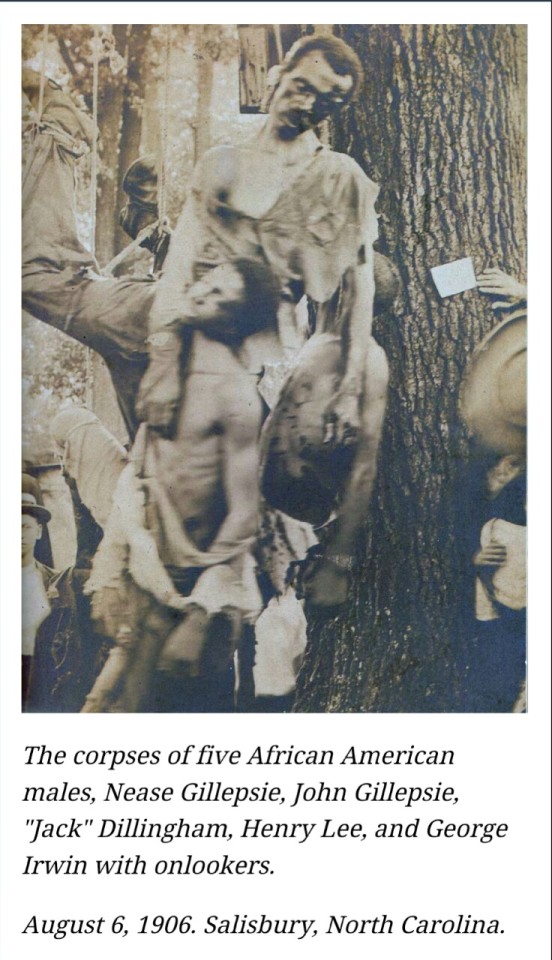

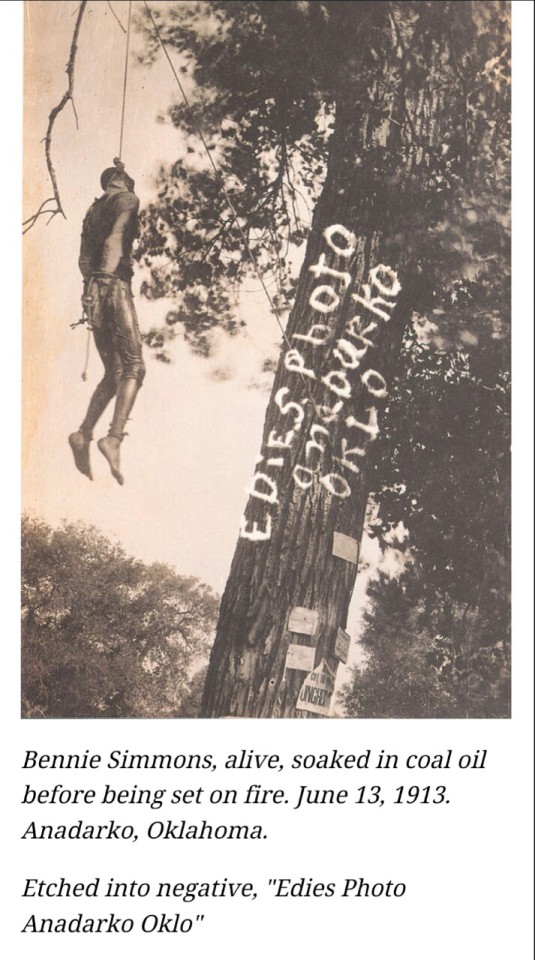
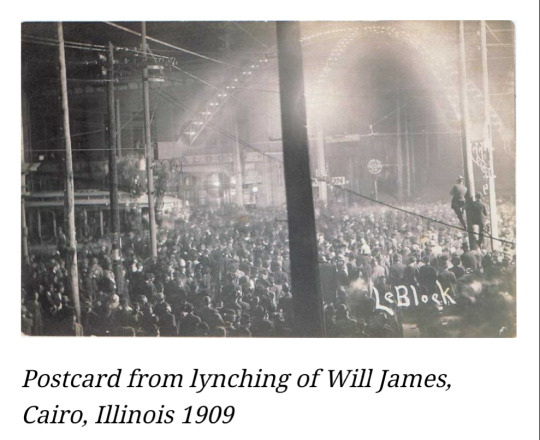
American Terrorism… Lynching Postcards
Terrorism is defined as “the use of violence and intimidation in the pursuit of political aims.” Western media likes to paint terrorists with a brown face, but one of the most horrific campaigns of terror happened in the past century on American soil – the estimated 3,436 lynchings of black American men and women between 1882 and 1950, intended to control and intimidate the recently freed black population. There is nothing more disturbing than being confronted with visual evidence of humanity’s dark heart, especially when it is evidence of a widespread, mainstream hatred for and violence towards one another. Hatred that stems from fear, and is driven by religion and a belief that murder is morality made distorted flesh; violence that aims to cow and suppress any aspirations a community might have for equality and a brighter future.
When I came across this collection of American postcards from James Allen and John Littlefield, published in a book entitled Without Sanctuary, I saw how important it is to look at these images, today more than ever. These postcards were made to commemorate events that made many American white people feel proud – of their race, of their superiority, of their civilization and their intelligence. They took photos of their disgusting, cowardly accomplishments and memorialized them for future generations, to be found and collected and remembered by their descendents. On the backs, they wrote to friends and family in sociopathic excitement about the mob the participated in. These postcards capture the mobs witnessing with glee the murder of young men and women, whose most serious crime was the color of their skin. The corpses hanging and charred in these postcards lived in a world that counted down the days until their murder from the second they drew air into their infant lungs. This history is potent, stomach-churning and of essential importance to the America of today, and to the world of today. And the most striking thing about these photographs is that they don’t erase the perpetrators like many histories and memorials do today, preferring to focus on who was victimized rather than on those who proudly – and with government backing – tortured, raped and murdered people. The murderers in these photos stand proud, grown men looking at the camera with the smiling conviction that the teenage boy they just killed, one against a hundred, was deserving of their hatred, fear and frustration. No grand jury needed; the law was in the hands of the murderers.
History is not linear; history is happening all around us, all the time. These photos are context, they are reality, they are pictures of American terrorism. Read James Allen’s commentary below and be aware that these photos are sickening, and all too real.
Africans in America mounted resistance to white people lynchings in numerous ways. Intellectuals and journalists encouraged public education, actively protesting and lobbying against lynch mob violence and government complicity in that violence. The National Association for the Advancement of Colored People (NAACP), as well as numerous other organizations, organized support from white and black Americans alike and conducted a national campaign to get a federal anti-lynching law passed. African American women’s clubs raised funds to support the work of public campaigns, including anti-lynching plays. Their petition drives, letter campaigns, meetings and demonstrations helped to highlight the issues and combat lynching.[4] In the Great Migration, extending in two waves from 1910 to 1970, 6.5 million African Americans left the South, primarily for destinations in northern and mid-western cities, both to gain better jobs and education and to escape the high rate of violence.
From 1882 to 1968, “…nearly 200 anti-lynching bills were introduced in Congress, and three passed the House. Seven presidents between 1890 and 1952 petitioned Congress to pass a federal law.”[5] In 1920 theRepublican Party promised at its national convention to support passage of such a law. In 1921 Leonidas C. Dyer from Saint Louissponsored an anti-lynching bill; it was passed in January 1922 in the United States House of Representatives, but a Senate filibuster by the Southern white Democratic block defeated it in December 1922. With the NAACP, Representative Dyer spoke across the country in support of his bill in 1923 and tried to gain passage that year and the next, but was defeated by the Southern Democratic block.
89K notes
·
View notes
Photo





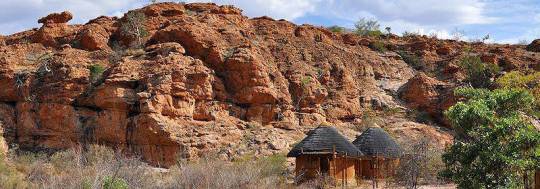

The Kingdom of Mapungubwe (or Maphungubgwe) (c.1075–1220) was a medieval state in South Africa located at the confluence of the Shashe and Limpopo rivers, south of Great Zimbabwe. The name is derived from either TjiKalanga and Tshivenda. The name might mean “Hill of Jackals”. The kingdom was the first stage in a development that would culminate in the creation of the Kingdom of Zimbabwe in the 13th century, and with gold trading links to Rhapta and Kilwa Kisiwani on the African east coast. The Kingdom of Mapungubwe lasted about 80 years, and at its height the capital’s population was about 5000 people.
This archaeological site can be attributed to the BuKalanga Kingdom, which comprised the Kalanga people from northeast Botswana and western Zimbabwe, the Nambya south of the Zambezi Valley, and the Vha Venda in the northeast of South Africa. The Mapungubwe Collection of artifacts found at the archaeological site is housed in the Mapungubwe Museum in Pretoria.

The largest settlement from what has been dubbed the Leopard’s Kopje culture is known as the K2 culture and was the immediate predecessor to the settlement of Mapungubwe. The people of the K2 culture, probably derived from the ancestors of the Shona and Kalanga people of southern Africa, was attracted to the Shashi-Limpopo area, likely because it provided mixed agricultural possibilities.The area was also prime elephant country, providing access to valuable ivory. The control of the gold and ivory trade greatly increased the political power of the K2 culture. By 1075, the population of K2 had outgrown the area and relocated to Mapungubwe Hill
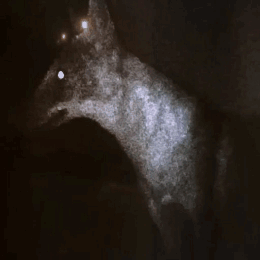
The capital of the kingdom was called Mapungubwe, which is where the kingdom gets its name. There is controversy regarding the origin and meaning of the name Mapungubwe. Conventional wisdom has it that Mapungubwe means “place of jackals,” or alternatively, “place where jackals eat”, thavha ya dzi phunguhwe, or, according to Fouché—one of the earliest excavators of Mapungubwe—"hill of the jackals" (Fouché, 1937 p. 1). It also means “place of wisdom” and “the place where the rock turns into liquid"—from various ethnicities in the region including the Pedi, Sotho, Venda and Kalanga.

Mapungubwean society is thought by archaeologists to be the first class-based social system in southern Africa; that is, its leaders were separated from and higher in rank than its inhabitants. Mapungubwe’s architecture and spatial arrangement also provide “the earliest evidence for sacred leadership in southern Africa”. Life in Mapungubwe was centred on family and farming. Special sites were created for initiation ceremonies, household activities, and other social functions. Cattle lived in kraals located close to the residents’ houses, signifying their value. Most speculation about society continues to be based upon the remains of buildings, since the Mapungubweans left no written record. The kingdom was likely divided into a three-tiered hierarchy with the commoners inhabiting low-lying sites, district leaders occupying small hilltops, and the capital at Mapungubwe hill as the supreme authority. Elites within the kingdom were buried in hills. Royal wives lived in their own area away from the king. Important men maintained prestigious homes on the outskirts of the capital. This type of spatial division occurred first at Mapungubwe but would be replicated in later Butua and Rozwi states. The growth in population at Mapungubwe may have led to full-time specialists in ceramics, specifically pottery. Gold objects were uncovered in elite burials on the royal hill (Mapungubwe Hil
257 notes
·
View notes
Photo

PALMLIGHT (BeatTape)🎧OUTNOW🎧!! LINK IN BIO! https://www.instagram.com/p/BpKT3MQFqDQGfcKsiFTuxQol8jMkSiXvL7vGqk0/?utm_source=ig_tumblr_share&igshid=1x6lfjnzcyffo
2 notes
·
View notes
Text
Done! The first draft of my hymn book Adorations of the Netjeru is done! I currently have 92 hymns in total, and each are between six and eight lines. Written in rhyming couplets, this has taken me way longer than I thought it would!
The gods that will be featured are (in alphabetical order);
Aker
Akhty
Amesemi
Amun
Amunet
Andjety
Anhur
Anuket
Anup
Anupet
Apedemak
Aset
Atum
Banebdjedet
Bast
Bastet-Artemis
Bat
Bes
Dedwen
Djehuty
Geb
Hapi
Harpocrates
Hathor-Hera
Hatmehyt
Heh
Heka
Heqet
Hermanubis
Heru sa Aset
Heru Ur
Hethert
Hethert-Mut
Iah
Ihy
Isis
Isis-Aphrodite
Iusaaset
Kebechet
Kek
Khepri
Khnum
Khonsu
Ma’at
Maahes
Mafdet
Mehen
Mehet-Weret
Mehit
Menhit
Meretseger
Min
Montu
Mut
Nebet-Het
Nefertum
Neith
Nekhbet
Nun
Nut
Pakhet
Ptah
Ptah-Tatenen-Nun
Ra
Raet-Tawy
Renenunet
Satet
Sebiumeker
Sekhmet
Selket
Serapis
Set
Set-Heru
Shu
Sobek
Sobek-Ra
Sokar
Sopdet
Sopdu
Suchos of the Faiyum
Tatenen
Taweret
Tefnut
Tenenet
Thoth-Hermes
Thoth of Pnubs
Wadjet
Wadj-Wer
Wenut
Wepwawet
Wesir
Zeus-Ammon
81 notes
·
View notes
Photo
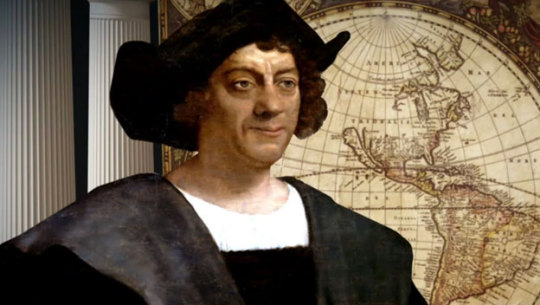
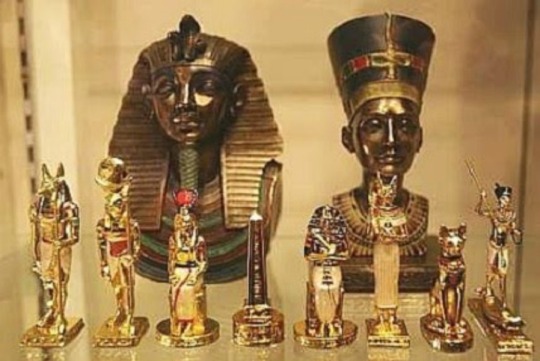
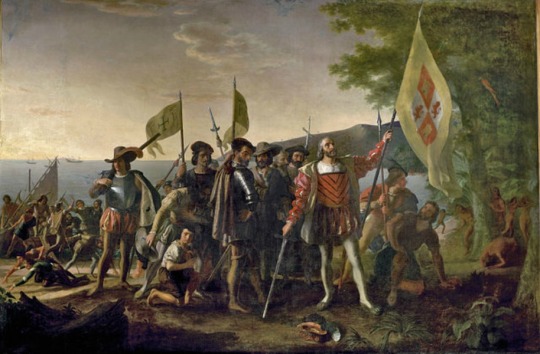
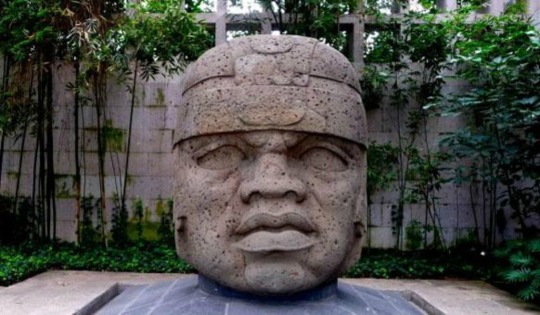
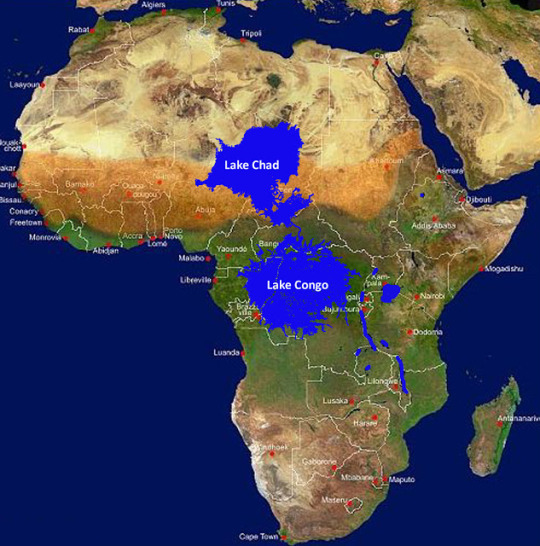


PROOF THAT AFRICANS WERE IN AMERICA BEFORE COLUMBUS!
Columbus Himself
According to renowned American historian and linguist Leo Weiner of Harvard University, one of the strongest pieces of evidence to support the fact that African people sailed to America before Christopher Columbus was a journal entry from Columbus himself. In Weiner’s book, “Africa and the Discovery of America,” he explains that Columbus noted in his journal that the Native Americans confirmed “dark brown” people had come from the south-east in boats, trading in gold-tipped spears.”
American Narcotics Discovered in Egyptian Mummies
The discovery of American narcotics in Egyptian mummies has left some historians amazed. Recently, archaeologists discovered the presence of narcotics only known to be derived from American plants in ancient Egyptian mummies. These substances included South American cocaine from Erythroxylon and nicotine from Nicotiana tabacum. German toxicologist Svetla Balabanova reported the findings, which suggest that such compounds made their way to Africa through trans-Atlantic trade that would predate Columbus’ arrival by thousands of years.
North America
For years, Eurocentric archaeologists have largely turned the other cheek when it came to the discovery of artifacts from ancient Egypt being discovered in the Americas. According to Dr. David Imhotep, the author behind the book “The First Americans Were Africans: Documented Evidence,” “Egyptian artifacts found across North America from the Algonquin writings on the East Coast to the artifacts and Egyptian place names in the Grand Canyon” are all signs of an early arrival in the Americas by Africans. This is also paired with a much earlier account of African people with incredible skills at sea. Back in 445 B.C., the Greek historian Herodotus wrote of King Ramses III leading a team of Africans at sea with astounding seafaring and navigational skills. Together, both accounts would point to Africans sailing over to the New World before Columbus.
Ancient Pyramids
Constructing pyramids was a highly specialized and complicated task that took the ancient Egyptians a lot of time to master. In ancient Egypt, there are signs of progression from the original stepped pyramid of Djoser to the more sophisticated pyramids that now stand at Giza. According to historians, it would be impossible for any group of people to have built those same complex pyramids without going through the same progression. Professor Everett Borders noted the presence of completed pyramids in La Venta in Mexico but the unusual absence of any earlier forms of the pyramids. According to Borders, it’s a sign that Africans, having already mastered the construction of pyramids in Egypt, sailed over to the New World and constructed these dual-purpose tombs and temples in the Americas.
Ancient African Skeletons Discovered in the New World
There have been many instances of archaeologists discovering skulls and skeletons that they believed clearly belonged to people of African descent. Polish professor Andrzej Wiercinski revealed the discovery of African skulls at Olmec sites in Tlatilco, Cerro de las Mesas and Monte Alban. Even more ancient African skeletons that would clearly predate Columbus’ arrival in the Americas were discovered throughout Central America and South America with some even being unearthed in what is now California.
A Clear Link in Religion
The similarities in Native American and African religions also suggest that Africans had to have had early contact with the Native Americans by sailing to the New World. Before Columbus stumbled upon the Native Americans’ land, there were prominent figures of deities with dark skin and coarse hair throughout their religion. Today, many surviving portraits reveal these deities who were clearly crafted in the likeness of Africans. Historians also point to wall paintings in caves in South America that depict the ancient Egyptian “opening of the mouth” and cross libation rituals.
The Accounts of Other European Explorers
Christopher Columbus wasn’t the only European explorer who made note of an African presence in the Americas upon his arrival. Historians revealed that at least a dozen other explorers, including Vasco Nunez de Balboa, also made record of seeing “Negroes” when they reached the New World. The accounts match up with the reports from the natives in Mexico. Nicholas Leon, an eminent Mexican authority, recorded the oral traditions of his people and ultimately kept track of a key piece of evidence that African people made it to the New World far before their European counterparts. His reports revealed accounts from natives saying “the oldest inhabitants of Mexico were African. [T]he existence of Africans and giants is commonly believed by nearly all the races of our sail and in their various language they had words to designate them.”
Africans Were Master Shipbuilders
Some people insist that Africans couldn’t have made it to the New World first simply because they didn’t have the skill and resources to sail across the Atlantic. As it turns out, that’s completely false. Historians have discovered evidence that suggests Africans were masters at building ships and that it was actually a part of their tradition. Shipbuilding and sailing are over 20,000 years old in the Sahara, and cave wall paintings of ancient ships were displayed in National Geographic magazine years ago. With those shipbuilding skills and the navigation skills that were noted by other historians of the time, the myth that Africans wouldn’t have been able to sail to the New World becomes officially debunked. As Dr. Julian Whitewright, a maritime archaeologist at the University of Southampton, explained, the voyage from Africa on ancient ships was “quite a plausible undertaking, based on the capabilities of the vessel of the period and historical material stating it took place.”
Gigantic Stone Heads in Central Mexico
The Olmec civilization was the first significant civilization in Mesoamerica and deemed “Mother Culture of Mexico” by some historians. This civilization dominated by Africans is best known for the colossal carved heads in Central Mexico that serve as even more evidence that Africans sailed to the New World before Columbus. The heads are clearly crafted in the likeness of Africans. The same civilization that created these giant heads was also responsible for introducing written language, arts, sophisticated astronomy and mathematics to Mesoamerican civilization, ancient African historian Professor Van Sertima explained.
A Long History of Trade by Sea
According to Paul Alfred Barton, the author of “A History of the African-Olmecs: African Civilizations of America from Prehistoric Times to the Present Era,” ancient kingdoms in West Africa have a long history of trade by sail, which made it all the more likely that they eventually expanded their trade to the Americas. While the Sahara is a dry desert today, its past as a lake-filled, wet and fertile place has been well-documented. African ships often crossed these large lakes to get from place to place and traded with other African civilizations along the way. After expanding their trade to the Americas, they certainly made their mark as things like African native cotton were soon being discovered all across North America.
https://www.youtube.com/watch?v=Hu0z6zyc2J8
7K notes
·
View notes
Text
UPG. Living in Ma’at Guide
Hello everyone, this is the Priest(tess) mentioned in Prince’s Kemetic guide about Set, here to compile my ideas for getting isfet and ma’at in some semblance of proper balance, at least in your immediate area, because it looks like the next couple months at least are going to be a riot.
Disclaimer: I’m neither a scholar nor a formal authority on the topic, and properly worship only one of the gods, which will color my perceptions, but I felt the need to share my thoughts on the matter nonetheless, due to circumstances that have cropped up in a lot of places, including my interactions with people and my own faith.
So, without further ado:
Welcome to Chess’ guide to adopting Ma’at into your daily life.
~!~
Part One: Ma’at is not peace.
Ma’at is usually translated as order, harmony, truth, and balance. That doesn’t mean it’s peace and quiet, though those can be side-effects.
Keep in mind:
The goal of Ma’at is to keep the world functioning as it should
Ma’at is objective
Ma’at counters Isfet, in every place that Isfet occurs
To practice Ma’at is to counter Isfet at its core, by every means you can. Means will be different from person to person, but the next part will cover common ways.
Part Two: Countering Isfet
Commonly perceived as doing things in old ways or rituals, but countering Isfet isn’t so simple as waving a candle and praying.
However, prayer does help a lot; sincere prayer, sans formality, sans pretention, is at its core one of the best ways to foster Ma’at in your life. Through prayer you can learn to speak freely and directly, which won’t always make things nice but if you’re true then you’re doing what needs to be done.
Directly, even, because fostering Ma’at in yourself and for the gods will directly affect their nature. The gods fight Isfet at every turn; to foster Ma’at is to aid the gods themselves, doing your part to keep the world turning.
However, prayer won’t be enough.
Here are other ways you can foster Ma’at through yourself and others.:
Bring others to an understanding
Bring others to an understanding
Draw out the truth of the matter before you
Practice emotional maturity and sincerity
Practice understanding when you or a situation needs help
Be fair and just even when (especially when) it’s inconvenient or someone is noisy about it
You don’t have to do all of them, but if you see the opportunity within your means, take it. Many of these will be difficult and frustrating, but in the end it will ease the pressure off your immediate area.
Everyone has a different way of doing things. More concrete examples would be like mediating or even facilitating an argument to draw out the grievances within and thus result in proper harmony, or advocating for reforms that will benefit those in need.
Part Three: Take care of yourself
I understand that these things can be dangerous to a lot of people. I understand that every one of these things can put your life on the line, in an abusive home or relationship, or a misguided community. Bear in mind: You cannot work Ma’at if you’re already dead, and the above are not absolutes.
Keep in mind:
Know when to stop and regroup; if you burn out that day, Ma’at will prosper later if you will yourself to keep a level head and fix the problem from inside.
Don’t sell yourself short; you have worth and to believe it will help you.
Understand people but separate your self from that of others; one of the fastest ways to burn out is to put yourself in every situation that you see Isfet in.
Cleanliness, organization, and proper nutrition all foster Ma’at; if you can’t do it for yourself that day, keep in mind that your gods need you to be in top form, and to do it for them or yourself is the same result.
Monitor yourself closely; unnecessary destruction of any kind, including of yourself through abuse or mishandling your capabilities, not only causes you trouble but also fosters Isfet in a lot of sometimes unnoticeable but later significant ways.
Don’t forget the little things; not everyone has the means to go out there and fight Isfet in big, flashy ways, and it’s equally important to keep your internal harmony and balance.
This isn’t to say to shy away from pain, but to know that you shouldn’t kill yourself over the work. If it hurts, understand why, and address it as positively as you can, by what means are available and in-line with Ma’at.
If you know it’s necessary, even if you’re afraid of it, voice your thoughts and do what must be done.
Part Four: Ma’at for the gods
The above covers Ma’at among people, and the below will cover Ma’at in your communication and interactions with your gods, whether scholarly or mystical.
Some of these were covered in the above, but here they are doubly emphasized:
Speak truly, clearly, and respectfully
Offer from the heart
Feel sincerely, but don’t let yourself be overwhelmed
Know when to draw the line, for yourself and for them
Let yourself believe you have influence, whether it sounds crazy or not
Be willing to listen and discern the truth from anything, direct or indirect
Be willing to consider both the negatives and positives of the gods, and reconcile them
Respect that some people will have unusual beliefs and interactions with their faith, differing from yours
FOR MYSTICAL KEMETICS: Be empathetic, but know your limits; be careful with what they ask of you, and whether or not it will be good for both of you, and whether or not you yourself are influencing what you might hear; understand that some people don’t believe the way you believe and that’s fine, the gods have accounted for such.
FOR SCHOLARLY KEMETICS: Respect that some kemetics believe in the gods in a more direct fashion, that others will have differing interpretations of the gods and their stories, and that the truth of Ma’at is in the core of the stories and not the details, timeless and universal.
Part 5: Devotional activities
A word of notice first of all: This is a difficult faith to practice openly, but it’s one that shouldn’t be hidden away. If you can’t practice openly, this might not be the faith for you, at least at the current time.
That said, if you can devote only a small amount of time to the gods, do so as regularly as you can. Any activity can be a devotional if you offer it up to the gods you want to give it to, though some of them may have preferences.
Miscellaneous acts you can offer the gods:
Making a playlist
Cooking
Cleaning the house
Eating, as if you were sharing a meal off the same plate (pray over the food, say you’re offering it, ask them to share with you in the moment, that kind of thing)
Art or writing of any kind
Magic and rituals, if that’s your thing
Taking care of pets
Taking care of people
Talking to them (basically prayer, though with the express purpose of just talking; tell them about your day)
Exercise (yoga, aerobics, tai-chi, zumba; if you feel the burn you can offer it)
Playing music or singing
Playing games, whether videogames, puzzles, visual novels, or physical activities
Going places (museums and parks are a good choice, movies are also good)
Defending the truth
Calling for justice
Advocating for the proper treatment of those in need
Basically any projects or activities that take time and make you meditate on the gods or the activity in question, especially if you do it by yourself or can get a group moving in harmony.
You can also offer:
Things you find (cool pebbles, flowers, a nice purchase)
Things you own (jewelry, books, old things you’ve made)
Things you experience (a memory, a story, your feelings)
Significant moments in your life (celebrations, upheavals, opportunities)
With the above, remember: Offering doesn’t mean something is given up, but that it’s shared.
(Quick tip: I offer food off my plate because I can’t always make a shrine, and I do it by murmuring over it, “[god’s form of address], I offer you this [food, named as if you’re describing it to the judge of a cooking show], please enjoy this offering with me/eat together with me.” Modify as you please, but the basic idea is there.
This is specifically a devotional act if you eat slowly, enjoy the food, and have dinner conversation, so you might want to either save it for special meals or do it a lot and very quietly. When you’re done, thank them for sharing with you.)
Closing Remarks:
In the end, this is only a guide. Each of us fight Isfet and devote ourselves differently, personally, and most of all, with Ma’at, which might not always be fun but should always bring about something better than what came before.
Always keep in mind that what you do, what Ma’at is, is to make things better than they were before, as the world should be.
Thank you for reading!
If you have other questions about this guide or just want to talk about this kind of thing, please direct asks or messages to
chess-and-snickers.
606 notes
·
View notes
Photo




Nas, 2Pac, Biggie and Redman photographed by Al Pereira at club Amazon in NYC on July 23, 1993.
11K notes
·
View notes
Photo
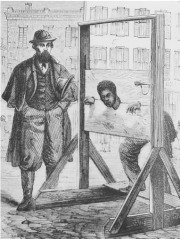
Check this out:
However, for some slave masters, whipping was exhausting. They also feared damaging any valuable workers. Stocks and pillories were invented as a means to punish slaves, and did not require much labor from the plantation owners. These contraptions would trap the limbs of slaves, and were usually placed in public. Field stocks often substituted flogging, and were very popular among the female slaves. Stocks were placed on the victim’s hands, which were adjusted above her head. horizontal stocks were provided for her feet. The hand stocks were usually raised high enough so that the slave’s toes no longer touched the ground, placing their entire body weight on their wrists and toes. Lead or iron weights were sometimes secured to the wrists in order to increase the punishment.
http://unitedstateshistory1492-1877.pbworks.com/w/page/16823397/Chapter%204
101 notes
·
View notes
Photo

Breaking on the wheel was the most horrific punishment ever visited on a convicted criminal. It was a form of crucifixion, but with several cruel refinements; in its evolved form, a prisoner was strapped, spreadeagled, to a large cartwheel that was placed axle-first in the earth so that it formed a rotating platform a few feet above the ground. The wheel was then slowly rotated while an executioner methodically crushed the bones in the condemned man’s body, starting with his fingers and toes and working inexorably inward. An experienced headsman would take pride in ensuring that his victim remained conscious throughout the procedure, and when his work was done, the wheel would be hoisted upright and fixed in the soil, leaving the condemned to hang there until he died from shock and internal bleeding a few hours or a few days later.
“Breaking” was reserved for the most dangerous of criminals: traitors, mass killers and rebellious slaves whose plots threatened the lives of their masters and their masters’ families. Yet in the case of one man who endured the punishment, a slave known as Prince Klaas, doubts remain about the extent of the elaborate conspiracy he was convicted of organizing on the West Indian island of Antigua in 1736. The planters who uncovered the plot, and who executed Klaas and 87 of his fellow slaves for conceiving of it, believed it had as its object the massacre of all 3,800 whites on the island. Most historians have agreed with their verdict, but others think the panicky British rulers of the island exaggerated the dangers of a lesser plot—and a few doubt any conspiracy existed outside the minds of Antigua’s magistrates.
Read more: http://www.smithsonianmag.com/history/antiguas-disputed-slave-conspiracy-of-1736-117569/#iMheuTDj6WUkkIx4.99
209 notes
·
View notes

